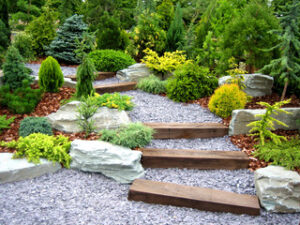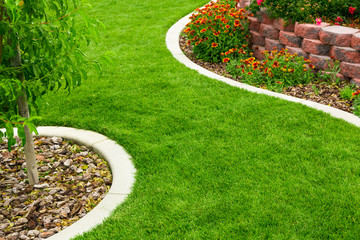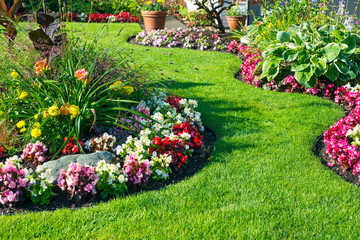Landscaping – The Art of Arranging and Shaping Surface Areas Around Your Home
Landscaping is the art of arranging and shaping the surface areas around your home. It involves several different elements and techniques like color, line, and focal points.

Landscaping Baltimore is a great way to show off your property. It attracts buyers, increases curb appeal, and boosts your home’s value. It also has many environmental benefits.
The design of landscapes reflects the style, personality and values of those who create them. As a creative and artistic form of expression, it is an important part of the world around us. It is also an important tool in maintaining a healthy environment. The design of a landscape involves the use of various plants and other materials that can be combined to produce a beautiful outdoor environment. It can be used for both commercial and residential purposes.
Landscape architects must consider many aspects of a property, including its location and the natural environment. They must consider the climate and weather patterns, soil types and the availability of water. In addition, they must take into account the existing vegetation and other structures on the site. They must also create an overall plan for the site. This includes determining the appropriate plant selections and their placement, as well as the design of the walkways, driveways and other hardscaping elements.
Modern sustainable landscaping practices focus on reducing the amount of resource exploitation needed to maintain the landscape. The main reason for this is to reduce the impact on the natural ecosystems that support the global environment. There are several ways to achieve this, but the most common method is to minimize the impact on the soil, water and air. This is done by using sustainable materials, maintaining natural contours of the land and incorporating native flora into the design.
Another way to be more sustainable is to reduce energy consumption. Using low-energy appliances, choosing plants that don’t require frequent watering and installing windbreak trees can help you save on your energy bills. You can also save money by using plants that provide insulation to your home and limiting the number of outdoor lights you use.
One of the most important elements of a landscape is its lines. Whether they are perceived or physical, they help guide the eye to focal points and create balance in the design. They also create visual contrast and can add depth to a space. Landscape designers also use lines to create pathways and connect different areas of the garden. Whether you’re creating a simple, rustic design or something more complex, using the right lines can make your landscape truly stand out.
Plants
Plants are the most important elements of the modern landscape. They serve multiple purposes and create a sense of place by giving continuity to the designed space.
Physical characteristics such as texture, form and color give plants their beauty and charm. They add interest and variety to the landscape by contrasting or complementing other plantings and hardscape elements such as patios, sidewalks, driveways and walls.
The plants chosen should be compatible with the landscape design and adapted to local climate, soil conditions and sun exposure. Water and maintenance requirements should also be taken into consideration. A landscaper should be able to help the homeowner determine which plants will thrive on site.
Trees add height, depth and structural contrast to the landscape. They can enhance a view, block noise and pollution, and provide shade to reduce summer temperatures. Trees can also serve as a focal point for the landscape and be used for screening, specimen planting and avenue planting.
Shrubs are another important landscaping element. They can be used for privacy screens, to soften the appearance of a home or building, and to attract birds and butterflies. For example, mock orange (Philadelphus spp) flowers in late spring and has a pleasant fragrance; it is an excellent landscaping shrub for the front of your home or around a walkway.
Ground cover plants such as trailing rosemary and salvia provide color and textural interest to a garden. They can also prevent erosion and weeds, and some are drought-tolerant. Some can become invasive, however, and should be pruned periodically to keep them in check.
Annuals, such as petunias and marigolds, are colorful additions to the landscape and often come back year after year. They are also easy to grow and maintain.
Native plants are better adapted to the local climate and soil conditions, making them more likely to survive and thrive. They are also less prone to pests and diseases. Native plants also offer other benefits to the environment, including encouraging local wildlife and pollinators and reducing water usage.
Other landscape elements such as boulders and gravel can be used to define areas, create a natural-looking setting and increase the visual appeal of a property. They can also be used to reduce stormwater runoff and improve soil quality.
Maintenance
Whether your garden is a place for a quiet escape, or your home’s exterior a welcome sight to visitors and passers-by, a well-kept landscape can bring joy to you and your guests. It also boosts your property value and offers other long-term benefits.
Landscapers can help you create the garden of your dreams. They will work with you to understand your vision, then design and install the space according to your preferences. Their services may include water gardening, planting and pruning trees and shrubs, laying mulch and adding decorative elements to the garden. They are also trained to provide maintenance for existing landscaping elements such as patios, decks, retaining walls and stone paving.
A landscaping transformation can be jaw-dropping. However, it is important to consider the ongoing needs of the space after the initial installation. For example, if you have chosen plants that will eventually grow to be taller than your home, they must be planted with the potential height in mind. They should also be planted in a way that does not interfere with your home’s architecture, block out windows or create a barrier between the garden and your home.
Landscaping is a broad term that includes all aspects of outdoor maintenance and repair. Gardeners are involved in all aspects of garden and plant care, and many of the same skills are required for commercial and residential landscapers. In addition, landscapers have a broader knowledge of outdoor spaces and can design more complex gardens.
The minimum requirement to be a landscaper is a high school diploma. However, more specific skills are learned through on-the-job training and apprenticeship. If the role involves working with pesticides or other chemical products, additional education and safety certification are required. A few positions require a bachelor’s degree in horticulture, arboriculture, landscape design or ecology.
Landscapers need to be proficient in both hardscaping and softscaping. Hardscaping refers to any permanent materials that are incorporated into the space, such as walkways, driveways and patios. Softscaping refers to all living items, such as trees, bushes and grass. The best landscapers are knowledgeable in both areas and can combine the two for a unique and functional space.
Value
A well-designed and maintained landscape can increase a home’s value significantly. It also provides numerous environmental benefits, including reducing erosion, conserving water, and improving soil quality. Additionally, landscaping can reduce energy costs by shading buildings and reducing the need for air conditioning. Landscaping also enhances the aesthetic appeal of a property and makes it more appealing to prospective buyers.
Whether you are considering selling your home in the future or you plan on staying for many years, making some landscape changes now can help you realize greater equity down the road. Generally, larger landscaping projects provide the best return on investment. However, you should keep in mind that not all projects are worth the cost. For example, if you install an expensive outdoor kitchen and then fail to maintain it, the project will be less valuable than it would have been if it had simply been installed and left to thrive.
When it comes to landscaping, curb appeal is one of the most important factors for increasing a home’s value. This is because the first impression that a potential buyer has of your home will be formed by what they see from the street. An overgrown lawn and unattended plants will give a bad impression, while a beautiful and well-maintained yard will entice them to schedule an appointment to view the house.
To maximize the impact of your landscape on your home’s value, it is essential to consider the style of your house and then incorporate design elements that will complement it. For example, if your house is decorated in warm neutral tones, you should choose plants and other elements that reflect this color palette. This will create a consistent design throughout the landscape and enhance your curb appeal.
In addition to the aesthetic and functional value of landscaping, it is also important to consider the impact that your landscaping has on the environment. By planting trees and other plants, you can help to combat the effects of global warming and climate change. In fact, a recent study found that trees can act as “nature’s air conditioner” by cooling the surrounding area.




